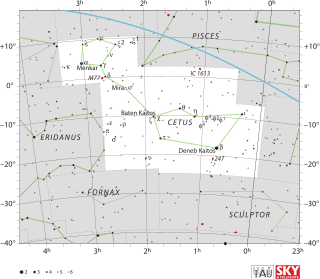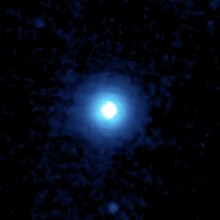
Apparent magnitude is a measure of the brightness of a star or other astronomical object. An object's apparent magnitude depends on its intrinsic luminosity, its distance, and any extinction of the object's light caused by interstellar dust along the line of sight to the observer.
In astronomy, absolute magnitude is a measure of the luminosity of a celestial object on an inverse logarithmic astronomical magnitude scale. An object's absolute magnitude is defined to be equal to the apparent magnitude that the object would have if it were viewed from a distance of exactly 10 parsecs, without extinction of its light due to absorption by interstellar matter and cosmic dust. By hypothetically placing all objects at a standard reference distance from the observer, their luminosities can be directly compared among each other on a magnitude scale. For Solar System bodies that shine in reflected light, a different definition of absolute magnitude (H) is used, based on a standard reference distance of one astronomical unit.

Vega is the brightest star in the northern constellation of Lyra. It has the Bayer designation α Lyrae, which is Latinised to Alpha Lyrae and abbreviated Alpha Lyr or α Lyr. This star is relatively close at only 25 light-years from the Sun, and one of the most luminous stars in the Sun's neighborhood. It is the fifth-brightest star in the night sky, and the second-brightest star in the northern celestial hemisphere, after Arcturus.

Radiometry is a set of techniques for measuring electromagnetic radiation, including visible light. Radiometric techniques in optics characterize the distribution of the radiation's power in space, as opposed to photometric techniques, which characterize the light's interaction with the human eye. The fundamental difference between radiometry and photometry is that radiometry gives the entire optical radiation spectrum, while photometry is limited to the visible spectrum. Radiometry is distinct from quantum techniques such as photon counting.

Luminosity is an absolute measure of radiated electromagnetic energy (light) per unit time, and is synonymous with the radiant power emitted by a light-emitting object. In astronomy, luminosity is the total amount of electromagnetic energy emitted per unit of time by a star, galaxy, or other astronomical objects.

In astronomy, photometry, from Greek photo- ("light") and -metry ("measure"), is a technique used in astronomy that is concerned with measuring the flux or intensity of light radiated by astronomical objects. This light is measured through a telescope using a photometer, often made using electronic devices such as a CCD photometer or a photoelectric photometer that converts light into an electric current by the photoelectric effect. When calibrated against standard stars of known intensity and colour, photometers can measure the brightness or apparent magnitude of celestial objects.

The cosmic distance ladder is the succession of methods by which astronomers determine the distances to celestial objects. A direct distance measurement of an astronomical object is possible only for those objects that are "close enough" to Earth. The techniques for determining distances to more distant objects are all based on various measured correlations between methods that work at close distances and methods that work at larger distances. Several methods rely on a standard candle, which is an astronomical object that has a known luminosity.
A spectroradiometer is a light measurement tool that is able to measure both the wavelength and amplitude of the light emitted from a light source. Spectrometers discriminate the wavelength based on the position the light hits at the detector array allowing the full spectrum to be obtained with a single acquisition. Most spectrometers have a base measurement of counts which is the un-calibrated reading and is thus impacted by the sensitivity of the detector to each wavelength. By applying a calibration, the spectrometer is then able to provide measurements of spectral irradiance, spectral radiance and/or spectral flux. This data is also then used with built in or PC software and numerous algorithms to provide readings or Irradiance (W/cm2), Illuminance, Radiance (W/sr), Luminance (cd), Flux, Chromaticity, Color Temperature, Peak and Dominant Wavelength. Some more complex spectrometer software packages also allow calculation of PAR μmol/m2/s, Metamerism, and candela calculations based on distance and include features like 2- and 20-degree observer, baseline overlay comparisons, transmission and reflectance.

In astronomy, magnitude is measure of the brightness of an object, usually in a defined passband. An imprecise but systematic determination of the magnitude of objects was introduced in ancient times by Hipparchus.
Xi Ursae Majoris is a quintuple star system 28.5 light-years away in the constellation of Ursa Major. It has the traditional name Alula Australis; Xi Ursae Majoris is the Bayer designation, which is Latinised from ξ Ursae Majoris and abbreviated Xi UMa or ξ UMa. It was the first visual double star for which an orbit was calculated, when it was computed by Félix Savary in 1828. It is also a variable star with a small amplitude. Xi Ursae Majoris is found in the left hind paw of the Great Bear.
Photographic magnitude is a measure of the relative brightness of a star or other astronomical object as imaged on a photographic film emulsion with a camera attached to a telescope. An object's apparent photographic magnitude depends on its intrinsic luminosity, its distance and any extinction of light by interstellar matter existing along the line of sight to the observer.
The AB magnitude system is an astronomical magnitude system. Unlike many other magnitude systems, it is based on flux measurements that are calibrated in absolute units, namely spectral flux densities.
In astronomy, the bolometric correction is the correction made to the absolute magnitude of an object in order to convert its visible magnitude to its bolometric magnitude. It is large for stars which radiate most of their energy outside of the visible range. A uniform scale for the correction has not yet been standardized.
In physics, the Sakuma–Hattori equation is a mathematical model for predicting the amount of thermal radiation, radiometric flux or radiometric power emitted from a perfect blackbody or received by a thermal radiation detector.

Lambda Ceti, Latinized from λ Ceti, is a B-type star of fifth-magnitude located in the constellation Cetus. Historically, the star bore the traditional name Menkar, although today that name is more commonly associated with α Ceti.
In astronomy, the color index is a simple numerical expression that determines the color of an object, which in the case of a star gives its temperature. The lower the color index, the more blue the object is. Conversely, the larger the color index, the more red the object is. This is a consequence of the logarithmic magnitude scale, in which brighter objects have smaller magnitudes than dimmer ones. For comparison, the whitish Sun has a B−V index of 0.656 ± 0.005, whereas the bluish Rigel has a B−V of −0.03. Traditionally, the color index uses Vega as a zero point. The blue supergiant Theta Muscae has one of the lowest B−V indices at −0.41, while the red giant and carbon star R Leporis has one of the largest, at +5.74.

Lambda Pegasi is a fourth-magnitude star in the constellation Pegasus.
Lambda Gruis, Latinized from λ Gruis, is a solitary, orange-hued star in the southern constellation of Grus. With an apparent visual magnitude of 4.47, it is visible to the naked eye as a faint point of light. The distance to this star, as determined using an annual parallax shift of 13.47 mas as seen from the Earth, is around 242 light years. It is drifting further away with a radial velocity of +39 km/s, having come to within 183 light-years some 805,000 years ago.










